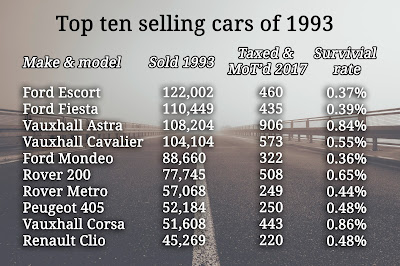At the beginning of the year, we posted a blog listing all the major automotive anniversaries and celebrations that will be taking place over the course of 2018. However, there was one glaringly obvious one missing from the line up, and that's because we were saving it for its own, dedicated post ...
Of course, I'm talking about the 70th anniversary of the Land Rover! First launched at the Amsterdam motor show back in April 1948, the Series I Land Rover was created for no other reason than to provide a stop-gap model to aide sales in the post-war years. This vehicle was first intended to be just for agricultural purposes, and had a box section steel chassis, and aluminium body work – there was an abundance of aluminium surplus from aircraft manufacturing after the war. Over the years, the Land Rover has developed to become so much more than a farmer's mode of transport, becoming a mainstay for the British Army and utilised by a number of different services, from the Police force to the National Trust. Nowadays, there is a whole range of Land Rovers available, such as the Defender, Discovery, Freelander, Range Rover, Range Rover Sport, and Range Rover Evoque. They are just as popular with the rich and famous as they are with your average country farmer – even the Duchess of Cambridge drives a Range Rover!
We have a number of books due to be released over the course of the year to help mark this landmark occasion, but the stand out book has got to be
Land Rover Design – 70 years of success. Written by Nick Hull, author of
Ford Design in the UK – 70 years of success – this book details the personalities involved in the various projects from the late 1940s up to today: the designers, modellers and studio engineers. It charts the development of Land Rover and Range Rover projects in the UK, particularly those designed in the Gaydon studio that opened in 1996, and is still a key part of Jaguar Land Rover's design resource. From the early days of chalk drawings and wooden models to today's digital renderings and milled clay for the latest Range Rover Evoque, Land Rover's designers and technicians have never been short of creativity. This book tells their story, in their own words, and is a fitting tribute to the spirit and ethos of Land Rover design and engineering.
To coincide with the marque's platinum anniversary, Land Rover are set to unveil a limited-edition high-performance version of the iconic Defender, with up to 150 V8-powered examples re-engineered.

The Defender Works V8 pays homage to the early high-powered engines in both the Series III Stage 1 V8 from 1979, and subsequent Defenders, including the 50th Anniversary Edition, which are highly sought after by enthusiasts and
collectors today. Defender Works V8 is the most powerful and fastest version that Land Rover has ever created. The 5.0-litre naturally-aspirated petrol V8 powertrain produces 405PS and 515Nm of torque (the standard Defender delivered 122PS and 360Nm). The Defender Works V8 will accelerated from 0-60mph in 5.6 seconds, while top speed is increased to 106mph.
Tim Hannig, Jaguar Land Rover Classics Director, said: "It's fitting that we've been able to release the full potential of the iconic Defender, whose much-loved shape remains synonymous with Land Rover, 70 years since is was seen in public for the first time. The idea of reintroducing a V8 Defender was something we were discussing as far back as 2014, when we were still building the Defender in Solihull. We knew the demand was there for a powerful and fast Defender; the Land Rover authenticity is the ultimate finishing touch for discerning clients purchasing these collector's edition Defenders."

The V8 powertrain will be fitted to 150 specially-selected and re-engineered Defenders for the 70th Edition, complemented by an eight-speed ZF automatic transmission with sport mode, uprated brakes, and handling kit (springs, dampers and anti-roll bars), plus exclusive 18-inch diamond-turned Sawtooth alloy wheels and 265/65 R18 all-terrain tyres. Eight standard body colours include two satin finishes – contrasting with Santorini Black roof, wheel arches and front grille – finished with machined aluminium door handles, fuel filler cap and Defender bonnet lettering. A comprehensive lighting upgrade includes bi-LED headlamps. Full Windsor Leather interior trim covers the dashboard, door panels, headlining and Recaro sports seats. Land Rover Classic's own Classic Infotainment System is also fitted. Both 90 and 110 wheelbase Defender Works V8 derivatives will be available to purchase soon from Land Rover Classic, including power upgrades for the TDCi diesel, fast-raid suspension, and braking kits.
There are a number of events that will be taking place, hosted by Land Rover and other motoring organisations, in order to celebrate 70 years of the marque. First on Land Rover's calendar is a unique restoration project, featuring one of the original launch vehicles from the 1940s!
For years the whereabouts of this particular launch car was a mystery. Last on the road in the 1960s, it went on to spend 20 years in a Welsh field, before being brought with every intention of a restoration that never happened. Having spent a fair amount of time sitting dilapidated in someone's garden, it turned up just a few miles outside of Solihull, where the Land Rover was first built – what a surprise to find it had made its way back home!
 |
| Image courtesy of Land Rover |
The team at Jaguar Land Rover Classic will follow a dedicated process to restore the launch vehicle, which has lots of special features that are unique to the 48 pre-production Land Rovers that were made prior to the mass production run, which includes thicker aluminium body panels, a galvanised chassis and a removable rear tub. The patina of its components will be preserved, including the original Light Green paint applied in 1948.
Come summer time, this year's Classic & Supercars Show will have the Land Rover's 70th anniversary as the main focus of the event. Taking place on the 15th of July, this prestigious charity event will pay homage to this iconic piece of British history.
"Land Rovers, for me, signify the best of British and I'm looking forward to seeing the range from 1948 Series I to the very latest Range Rovers all on display," says Classic & Supercars Show Chairman, Nigel Young.
Needless to say, there will be plenty to keep Land Rover fans entertained over the course of 2018! And I'm sure we will be posting much more about this iconic marque through the year, so keep an eye out on our blog, Facebook, Twitter and On The Grid newsletter!

 But it wasn't only racing where Gurney made his considerable mark. Constructor and team owner are also prominent on his CV, and his Eagle-Weslake cars are still considered as one of the most visually stunning F1 cars of all time.
But it wasn't only racing where Gurney made his considerable mark. Constructor and team owner are also prominent on his CV, and his Eagle-Weslake cars are still considered as one of the most visually stunning F1 cars of all time.

















